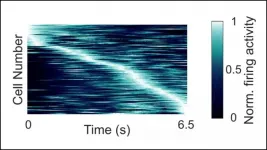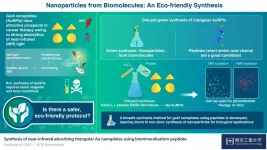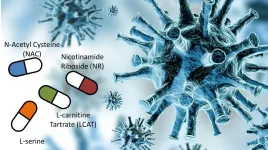(Press-News.org) The exoplanet satellite hunter CHEOPS of the European Space Agency (ESA), in which the Instituto de Astrofísica de Canarias (IAC) is participating along with other European institutions, has unexpectedly detected a third planet passing in front of its star while it was exploring two previously known planets around the same star. This transit, according to researchers, will reveal exciting details about a strange planet "without a known equivalent".
The discovery is one of the first results of CHEOPS (CHaracterising ExOPlanet Satellite) and the first time that an exoplanet has been seen with a period longer than 100 days transiting a star which is sufficiently bright to be seen with the naked eye. The discovery was published today in the journal Nature Astronomy.
This bright star similar to the sun, called Nu2 Lupi, is a little more than 50 light years from Earth, in the constellation of Lupus. In 2019, HARPS (High Accuracy Radial velocity Planet Searcher) of the European Southern Observatory (ESO) in Chile discovered three exoplanets in this system (called b, c, and d) with masses between those of the Earth and Neptune, and with orbital periods of 11.6, 27.6 and 107.6 days respectively. Afterwards NASA's TESS satellite, designed to detect transiting planets, found that the two interior planets, b and c, transit Nu2 Lupi, making it one of the only three naked eye stars which have more than one transiting planet.
"Transiting systems such as Nu2 Lupi are of great importance in our understanding of how planets form and evolve, because we can compare several planets around the same bright star in detail", explains Laetitia Delrez, a researcher at the University of Liege (Belgium) and first author of the article.
"Our idea was to follow up previous studies of Nu2 Lupi and to observe planets b and c passing in front of Nu2 Lupi with CHEOPS, but during a transit of planet c we were amazed to see an unexpected transit of planet d, which is further out within the system", she adds.
Transits of planets give a valuable opportunity to study their atmospheres, their orbits, their sizes and their compositions. A transiting planet block out a tiny but detectable proportion of the light of its star when it passes in front of it, and it was this tiny drop in the light which led the researchers to their discovery. Because exoplanets with long periods orbit far away from their stars, the possibility of detecting a planet during transit is very small indeed, which makes the finding with CHEOPS a real surprise.
Using the high precision techniques of CHEOPS planet d was found to have some 2.5 times the radius of the Earth, and its orbital period around its star of a little over 107 days, was confirmed. In addition, using archive observations from terrestrial telescopes its mass could be estimated at 8.8 times that of the Earth.
"The amount of radiation from the star which falls onto planet d is quite small compared to many other known exoplanets. If it were in our own solar system Nu2 Lupi d would orbit between Mercury and Venus", says Mahmoudreza Oshagh, a senior postdoctoral researcher at the IAC, and a co-author of the paper. "Combined with its bright parent star, its long orbital period and its ideal situation for follow-up, this means that planet d is very exciting: it is an exceptional object, with no known equivalent, and it will certainly be a fundamental object for future studies".
The majority of long period transiting exoplanets discovered until now are orbiting stars which are too faint to allow detailed follow-up observations, which means that we know little about their properties. Nu2 Lupi is, however, sufficiently bright to be an attractive object for other powerful space telescopes such as the NASA/ESA Hubble Space Telescope, the future James Webb Space Telescope, as well as major observatories on the ground. "Given its general properties and its orbit, planet d will be an exceptionally favourable objective to study an exoplanet with a moderate atmospheric temperature around a star similar to the Sun", adds Laetitia Delrez.
Combining the new data from CHEOPS with archive data from other observatories, the researchers found that planet b is mainly rocky, while planets c and d appear to have large quantities of water surrounded by hydrogen and helium gas. In fact, planets c and d contain much more water than the Earth, a quarter of the mass of each of them is water, in comparison with less than 0.1% on Earth. But this water is not liquid, it is high pressure ice, or high temperature water vapour.
"Although none of these planets would be habitable, their diversity makes the system very exciting and a great future perspective to show how these bodies formed and how they have changed with time", explains Enric Pallé, an IAC researcher and a co-author of the article. "We can also look for rings or moons within the Nu2 Lupi system, because the extreme accuracy and stability of CHEOPS could allow us to detect bodies close to the size of Mars".
CHEOPS is designed to gather high precision data of individual stars known to harbour planets, rather than to make a more general survey of possible exoplanets around many stars. This approach and accuracy are proving exceptionally useful to understand the planetary systems around the stars around us.
"These exciting results show, yet again, the major potential of this satellite", says Enric Pallé. CHEOPS will not only give us a better understanding of known exoplanets, but as shown by this result and others in the initial phase of the mission, it will enable us to discover new ones, and to reveal their secrets".
INFORMATION:
Article: L. Delrez et al. "Transit detection of the long-period volatile-rich super-Earth Nu2 Lupi d with CHEOPS". 2021, Nature Astronomy. DOI: https://www.nature.com/articles/s41550-021-01381-5
Scientists of Tomsk Polytechnic University were able to obtain polytetrafluoroethylene (PTFE) membranes using electrospinning. PTFE is known to be the most stable existent polymer. According to the scientists, it is a simple, affordable and easily scalable method, which will allow obtaining chemically stable membranes in industrial-scale production. The membranes can be used in petrochemical, aerospace, nuclear industries, carbon-free energy and medicine.
The latest results of the research of physical and chemical properties and biocompatibility of the obtained membranes are published ...
The U.S. Food and Drug Administration's controversial decision to approve aducanumab for the treatment of Alzheimer's disease raises at least three major ethical issues that need to be addressed, states a new article in the Hastings Center Report:
Billions of dollars in Medicare resources (which is to say, taxpayer dollars) are at risk of being unjustly squandered.
Physicians must choose between facilitating this unjust squandering and denying desperate patients and families access to this drug.
Patients and families are having false hopes legitimated and encouraged when physicians prescribe aducanumab.
The drug's approval was contrary to the nearly unanimous judgment of an FDA advisory committee that there was little reliable evidence of significant ...
HOUSTON - (June 28, 2021) - Rice University computer scientists are sending RAMBO to rescue genomic researchers who sometimes wait days or weeks for search results from enormous DNA databases.
DNA sequencing is so popular, genomic datasets are doubling in size every two years, and the tools to search the data haven't kept pace. Researchers who compare DNA across genomes or study the evolution of organisms like the virus that causes COVID-19 often wait weeks for software to index large, "metagenomic" databases, which get bigger every month and are now measured in petabytes.
RAMBO, which is short for "repeated and merged bloom filter," is a new method that can cut indexing times for such ...
Neurons in the hippocampus fire during specific moments in time, according to research recently published in JNeurosci. The cells may contribute to memory by encoding information about the time and order of events.
Episodic memories involve remembering the "what, where, and when" of past experiences. The "where" may be encoded by place cells in the hippocampus, which fire in response to specific locations. Rodents have hippocampal neurons that fire in response to specific moments in time -- the "when" -- but until recently it was not known if the human brain contained them too.
Reddy et al. recorded the electrical activity of neurons in the hippocampus of epilepsy patients undergoing diagnostic invasive monitoring ...
In cancer therapy, the effectiveness of an approach is determined by its ability to preserve the non-cancerous cells. Simply put, the higher the collateral damage, the greater are the side-effects of a therapy. An ideal situation is where only the cancer cells can be targeted and destroyed. In this regard, photothermal therapy--an approach in which cancer cells infused with gold nanoparticles can be heated up and destroyed using near-infrared (NIR) light that is strongly absorbed by the gold nanoparticles--has emerged as a promising strategy due to its minimally invasive nature.
"Because NIR light is able to penetrate biological tissues, it can illuminate ...
The Structural Bioinformatics and Network Biology laboratory, led by ICREA Researcher Dr. Patrick Aloy, has completed the bioactivity information for a million molecules using deep machine-learning computational models. It has also disclosed a tool to predict the biological activity of any molecule, even when no experimental data are available.
This new methodology is based on the Chemical Checker, the largest database of bioactivity profiles for pseudo pharmaceuticals to date, developed by the same laboratory and published in 2020. The Chemical Checker collects information from 25 spaces of bioactivity for each molecule. These spaces are linked to the chemical structure of the molecule, the targets with which it interacts or the changes ...
For the first time, scientists from the German Cancer Consortium (DKTK) partner site in Essen/Düsseldorf have discovered stem cells of the hematopoietic system in glioblastomas, the most aggressive form of brain tumor. These hematopoietic stem cells promote division of the cancer cells and at the same time suppress the immune response against the tumor. This surprising discovery might open up new possibilities for developing more effective immunotherapies against these malignant brain tumors.
The DKTK is a consortium centered around the German Cancer Research Center (DKFZ) in Heidelberg, which has long-term collaborative partnerships with specialist oncological centers at universities across Germany.
Glioblastomas ...
Metabolic activators were found to reduce recovery time by as many as 3.5 days in patients with mild-to-moderate Covid-19, according to a Swedish-British study published today in Advanced Science.
The researchers also found that treatment with the metabolic activators improved liver health and decreased the levels of inflammation, as shown by inflammatory markers.
Conducted by researchers at Science for Life Laboratory at KTH Royal Institute of Technology in Stockholm, in collaboration with the Sahlgrenska Academy in Gothenburg and King's College, London, the ...
Want to have a happy relationship? Make sure both partners feel they can decide on issues that are important to them. Objective power measured by income, for example, doesn't seem to play a big role, according to a new study in the "Journal of Social and Personal relationships" by the Martin Luther University Halle-Wittenberg (MLU) and the University of Bamberg. Instead, how lovers perceive power dynamics in their relationship is most important for relationship satisfaction.
Power is about being able to influence people and successfully resist the attempts of others to influence you. "It sounds like a dog-eat-dog world or the world of business. ...
The examined tissue does not need to be marked for this. The analysis only takes around half an hour. "This is a major step that shows that infrared imaging can be a promising methodology in future diagnostic testing and treatment prediction," says Professor Klaus Gerwert, director of PRODI. The study is published in the American Journal of Pathology on 1 July 2021.
Treatment decision by means of a genetic mutation analysis
Lung tumours are divided into various types, such as small cell lung cancer, adenocarcinoma and squamous cell carcinoma. Many rare tumour types and sub-types also exist. This diversity hampers reliable rapid diagnostic methods in everyday clinical ...




